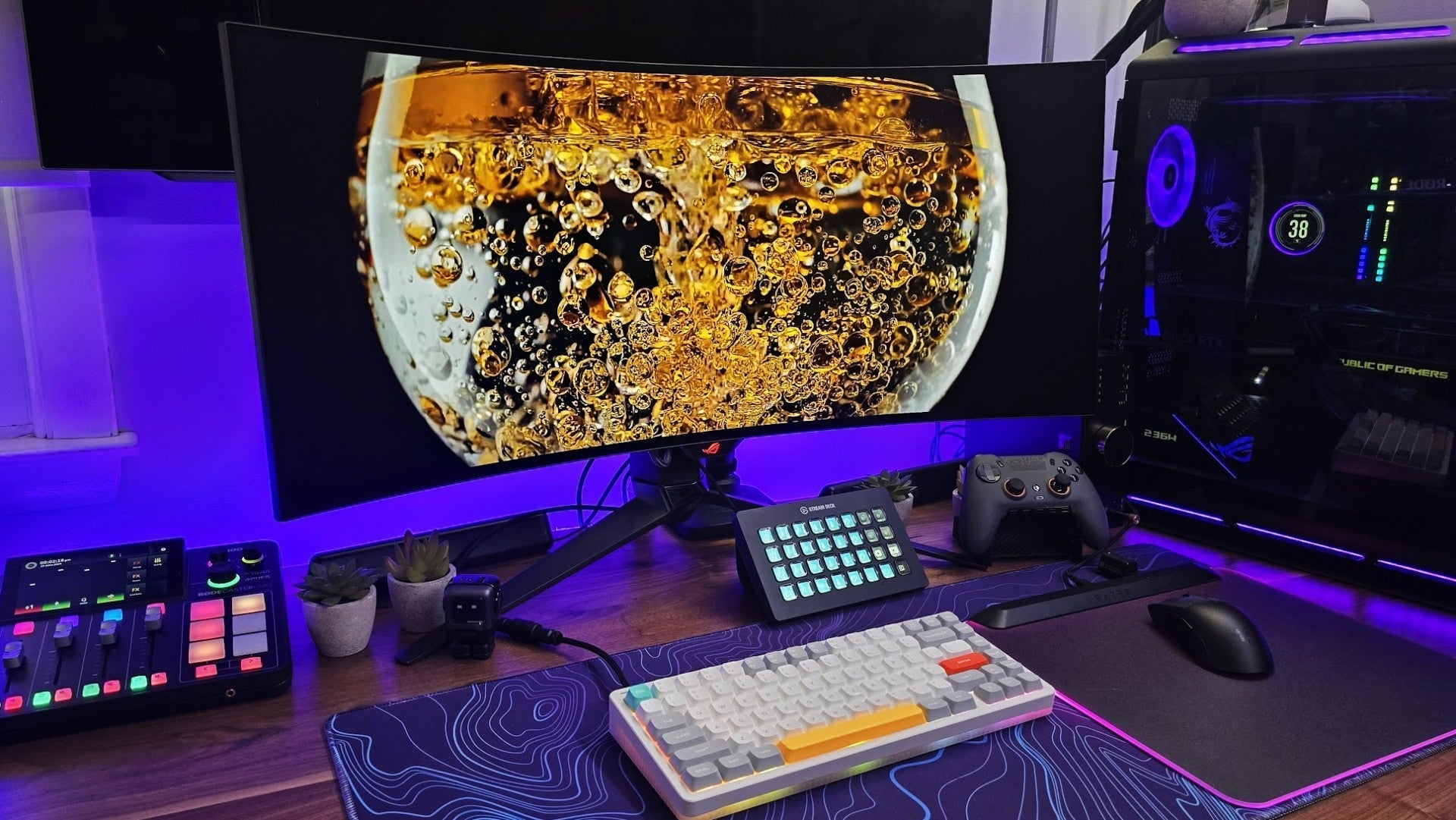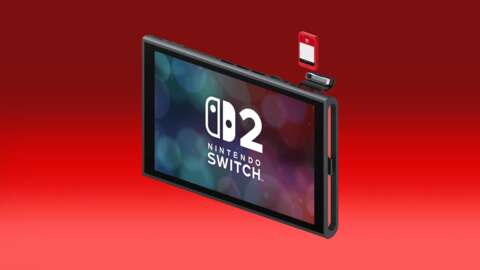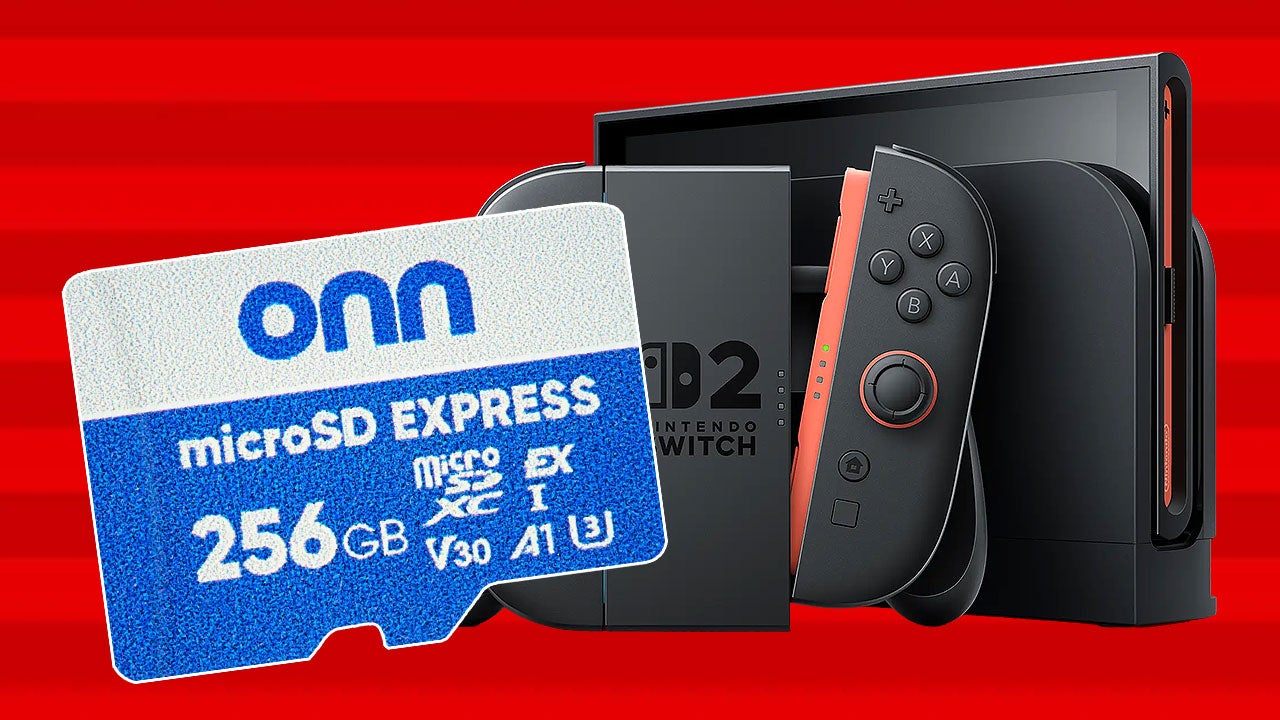
Ultrawide monitors may have been a niche in the past, but today, this spacious form factor has gone mainstream and it’s no wonder why. The extra screen real estate offers real benefits, whether you’re a gamer or an everyday computer user that’s interested in enhancing your experience in front of a screen. The best ultrawide monitors occupy multiple places in our best gaming monitor and computer monitor lists, but if you’re looking for the best of the best within this segment, look no further. These are the best ultrawide monitors of 2025.
TL;DR – These Are the Best Ultrawide Monitors:
The top ultrawide monitors offer all of the benefits of a standard monitor but with a 21:9 aspect ratio. While they are wider, they’re usually about the same height as a 23-24-inch monitor. Because of this, and the ability of different operating systems to lock windows to specific areas of the screen, they can also be a great way to replace a two-monitor setup and get rid of the distracting bezels separating two standalone monitors.
I've been testing and reviewing monitors of all kinds for years, and can confidently say that these are my favorite ultrawide options right now.

1. Asus ROG Swift PG39WCDM
Best Ultrawide Monitor
Asus has been at the forefront of the OLED gaming monitor game throughout this generation, and that also extends to ultrawides. In this case, we have the big kahuna: The ROG Swift PG39WCDM, a massive 39-inch 21:9 display with incredible brightness, contrast, and colors, fantastic responsiveness, stellar motion clarity, and a suite of features that make it hard to pass up. This is even more true now that its price has come down. As of this writing, I was able to find it for only $900, which, while expensive, is a steal for what you're getting.
If you've been on the fence about picking up an OLED monitor for yourself, it's about time to jump down. While there are still some minor drawbacks (like SDR brightness), the benefits far outweigh the sacrifices. Because each pixel is independently illuminated and controlled for brightness, it's able to offer infinite contrast for the deepest blacks and exceptional dynamic range without ever even turning on the HDR mode. When you do, you can unlock its full 1,300-nit brightness. Simply put, if you value picture quality, enjoy HDR games or movies, or just want a picture that will make you feel good about your investment. The ROG Swift PG39WCDM is a great choice.
It's not all about the picture, however. For gaming, you'll enjoy its rapid 240Hz refresh rate, which allows it to deliver exceptional motion clarity and input latency that's to the floor. This goes hand-in-hand with its naturally more responsive OLED panel, bringing total input delay down to 0.03ms. It's perfect for competitive gaming and, frankly, overkill for productivity. But any motion at all, even scrolling spreadsheets or webpages, or simply sliding your mouse cursor across your desktop, feels pleasantly smooth.
This display also packs a number of other features for gaming. It comes complete with a number of enhancements, including a Shadow Booster, Extreme Low Motion Blur (ELMB), on-screen reticles, Night Vision, and a Sniper Mode that works with the normal picture as well as its Night Vision mode. The panel itself also has a deep 800R curvature to enhance its immersiveness as it extends further into your peripheral vision.
For productivity – as well as for gaming – its integrated KVM allows you to swap platforms with a single button press. While some people might feel that its size and curvature are not ideal for productivity applications, I found the impact here to be much less significant than on other monitors with an identical curve. So clearly, Asus has done some tweaking to improve its clarity.
I was able to review the 34-inch version of this monitor and was floored. Even though it's been months since that review, it has still been my high-water mark, which makes it an easy pick for the best overall ultrawide you can get so far this year.

2. MSI Optix MAG342CQR
Best Budget Ultrawide Monitor
If you're looking for an ultrawide on a budget, it doesn't get much better than the MSI Optix MAG342CQR. At less than $300, it's not the very cheapest ultrawide you can find, but it's fully featured with a solid picture and impressive responsiveness. For the money, it's a standout value.
If I had to use a single word to describe the MAG342CQR, it would be balance. MSI clearly prioritized image quality and gaming performance, and its trade-offs all feel very fair for what it delivers in return: solid clarity, fast performance, very good colors, and a generous but not overstated curve.
Its resolution is crisp at 3440x1440 UWQHD, or ultrawide 1440p, while many "budget" ultrawides are still stuck at a wider 1080p. This is great for gaming and provides a noticeable bump to clarity without requiring a high-performance, high-cost computer to run at high frame rates. It also uses a VA panel which, while trading a bit on viewing angles and color reproduction, offers much better blacks than monitors using IPS panels (and colors still look great).
This monitor features a 144Hz refresh rate – not the highest, but perfect for gamers that aren't interested in esports-level competitive gaming – and supports variable refresh rate for smooth, tear-free gameplay whether you're gaming using an AMD or Nvidia GPU. It also has a 1500R curvature, which lands squarely in the middle-ground between "almost flat" 1800R and super-deep 800R.
So what are you trading with this monitor? Not ergonomics, like most in the budget sector. The stand offers height, tilt, and pivot so you can freely adjust it as needed. No, sacrifices really come down to peak brightness and connectivity. At 300 nits, it's bright enough to be enjoyable away from direct sunlight but will look dim if your PC is in front of a rear window. Connectivity is also limited to only HDMI 2.0 and DisplayPort 1.4, so you'll need to look elsewhere for your USB hub and headphone jack.
Still, this monitor nails what matters most and is a great choice for anyone on a budget.
3. Acer Predator X34 OLED
Best Ultrawide Gaming Monitor
It was a close call between the Acer Predator X34 OLED and the Asus ROG Swift PG39WCDM for the best choice for gamers. Ultimately, the X34 won out in the gaming-specific category due to its more traditional 34-inch size and the PG39WCDM's well-roundedness for productivity applications. The X34 is an excellent monitor across the board too, so feel free to tackle those spreadsheets and creative apps, but it's the best fit for gaming overall and that applies to competitive and single-player games alike.
It's on-paper specs compete with the best OLED monitors you can buy today. It features a resolution of 3440x1440, so games, movies, and pictures all look crisp and detailed. Its pixel-by-pixel controlled panel offers infinite contrast and a peak brightness of 1,300 nits for wide dynamic range. Blacks are pitch and highlights shine, which lends games a lifelike, immersive quality. It also runs at a 240Hz refresh rate with only 0.03ms of input latency, so ghosting and motion blur are concerns of the past.
In my review of the Predator X34 OLED, I was struck by its color reproduction. Acer has done an impressive job of dialing in its colors straight out of the box, so you won't need to worry about an aftermarket calibration if you need to use it for creative work. Even if all you're doing is gaming, which is where this monitor shines the most, you'll be impressed with how rich its colors are without touching a setting or enabling HDR.
The X34 comes with a deep dish 800R curvature. Compared to many competing monitors which might have a 1,500R or 1,800R radius, the X34's arc is much more pronounced. While this admittedly takes a bit of getting used to if you're new to this type of display, it's a boon to immersiveness as the screen seems to draw you into its center.
The biggest drawback to this display is that the text isn't quite as crisp as most similarly specced flat panel OLEDs released this year. It's still easily legible and a noticeable improvement from OLED monitors of years past that were plagued by clarity issues. But it's worth noting, if you do a lot of reading or productivity work on your monitor, as this may be slightly distracting. Still, for gaming, the Acer Predator X34 OLED is tops and well worth considering.

4. Dell Ultrasharp U3425WE
Best Ultrawide Monitor for Productivity
When I'm looking for a great productivity monitor, there are a few key things I'm on the lookout for: solid ergonomics, excellent clarity with enough screen real estate to easily take on multiple tasks at a time, wide viewing angles, and exceptional connectivity are each key to providing a great work experience. The Dell Ultrasharp U3425WE checks every one of those boxes and is the monitor to beat for productivity in 2025.
In addition to being a 34-inch ultrawide – essentially replacing two side-by-side monitors – its 3440x1440 resolution ensures that everything from text to pictures will be crisp and clear. It uses an IPS panel for wide viewing angles, and the stand offers a full suite of adjustments to quickly share your work with your colleagues. Its brightness isn't amazing at only 300 nits, but it's perfectly fine if you're not using it in direct sunlight. Still, this is the one area where I would like to see the U3425WE push a little further than it does.
What really sets this monitor apart, however, is its incredible connectivity. It features (deep breath): five USB 3.2 Gen 2 Type-A ports (one with BC 1.2 charging), two USB 3.2 Gen 2 Type-C ports with 15W PD charging, one Thunderbolt 4 (with DP Alt Mode and Power Delivery), and two upstream ports for Thunderbolt and USB to send power and data back to the host PC. It even includes a 2.5G ethernet port port, as well as HDMI 2.1 and DisplayPort 1.4 inputs, and a headphone jack. This massive array of ports allows the U3425WE to be the central hub for your computing experience, connecting to and charging multiple devices at once, and minimizing cable clutter between your laptop, desktop, and display.
This display goes a step further still by offering hardware level multi-stream transport. Without any additional software, it can partition the display in two and deliver a bezel-free multi-screen experience. If you are able to install software, I recommend picking up the Dell Peripheral Manager suite for additional partioning and customization options.
Though the monitor runs at an impressive 120Hz, it's not great for competitive gaming if you plan to multi-purpose it. Rapid responsiveness isn't on the priority list for productivity-based monitors, so instead of the 1ms or less response times, the U3425WE can only hit 5ms in its fastest mode. In its default Normal response-time mode, it clocks in at only 8ms. For single-player and slower-paced games, it's still very playable, but if you want a competitive edge, a gaming monitor is still the best choice.
For getting work done, however, this is a stellar pick, if a bit expensive. For all it offers, it's clear that Dell had the needs of desk workers clearly in its sights.

5. MSI MPG 491CQPX QD-OLED
Best 32:9 Super Ultrawide
Multi-monitor setups can be great, except for those darn bezels. This is doubly true if you like to use three monitors or are simply considering how to maximize or how to get the most space from your PC setup. Enter the MSI MPG 491CQPX QD-OLED monitor with a 49-inch corner-to-corner display and a 5120x1440 resolution display. It's the monitor to choose if you're in the market for the best super ultrawide monitor of the year.
Monitors like this aren't for everyone. At 49 inches, it is as wide as an entire desk. It is, in essence, three monitors combined into one – make that three 1,440p monitors combined into one, free of immersion-breaking bezels. Because its height is roughly that of a 24-inch display, its image clarity remains excellent, so you're not trading crispness for width.
That extra space doesn't go to waste. This is a modern QD-OLED, which means outstanding blacks, high peak brightness, and even better colors than a normal OLED. That "QD" in the name refers to Quantum Dots, a nano-layer within the screen that improves the vividness of colors and perceived brightness.
Between its 240Hz refresh rate, low input latency, and immersive size, it's a great display for gaming, but make no mistake: This monitor is great for productivity too. Taking in multiple windows, viewing complete timelines in video editing, referencing reports, spreadsheets, and sources while creating your own or taking a meeting are perfect fits for the MPG 491CQPX.
I won't sugar coat it. The first time I used a monitor of this width, I was out of my element. I review a lot of monitors and the 32:9 aspect ratio takes more getting used to than most. Its 1800R curve helps keep things crisp and productivity friendly, however, so you can go about that learning curve doing everything you normally would at your PC, making this particular learning curve easier to climb than it might otherwise.
And trust me, once you get used to it, you may never want to go back to a normal ultrawide again.
How to Choose the Best Ultrawide Monitor
Shopping for an ultrawide monitor isn’t that different from shopping for any other monitor, but there are still some key things you should look out for and keep in mind as you shop:
Size: The first thing to consider is how big of a monitor you need. Ultrawide monitors typically hover around 32-34 inches but there is a range on either side of that to meet different needs. There are also super ultrawides which use a 32:9 resolution and can replace a three-monitor setup, though these displays can be more challenging to run due to their higher resolution.
Resolution: The next thing to consider is the monitor’s resolution. Because they are essentially two monitors in one, I recommend focusing on the second figure for a quicker understanding of the level of clarity you should expect. A 2560x1080 monitor, for example, is about the same as two 1080p monitors; 3440x1440 is approximates two 1440p monitors, and so on. Remember, a higher resolution can improve picture clarity, but if you’re also planning on playing PC games on this display, those also require higher-powered hardware to achieve the same frame rates.
Curvature: Ultrawide monitors often come with curved displays but not always. The form factor lends itself to an arc and can make playing games feel more immersive. The curve of a monitor is described using an “R” value, the most common being 800R, 1500R, and 1800R. The higher the number, the shallower the curve. An 1800R curve isn’t very perceptible but an 800R curve can feel very pronounced and even make images and text appear warped. Try to see these different curves in person if at all possible.
Refresh Rate: A monitor’s refresh rate is how often it flashes its picture every second and can enhance the smoothness of motion. For productivity, the standard is 60Hz and you’ll have trouble finding anything less than that. For gaming, I recommend targeting 120Hz or higher for the best experience. Higher refresh rates, like 240Hz are often considered assets for first-person shooters where they can help improve clarity during fast motion, like rapid spins and flick-shots.
Panel Type: A monitor’s “panel” is its physical screen and there are several different technologies to choose from.
- In-Plane Switching (IPS): This very common panel type is widely regarded for its colors and viewing angles. It’s popular among creative professionals and gamers alike, though historically has been slower and more prone to ghosting. This is a much small issue today. These panels usually use an edge-lit backlight which causes them to have lower contrast and potential for backlight bleeding.
- Vertical Alignment (VA): VA panels are almost as common as IPS and typically offer slightly better responsiveness (though not always). Their colors and viewing angles aren’t quite as good as IPS but because they don’t use the same technology, offer much better contrast. They’re a good middle-ground between IPS and TN panels.
- Twisted Nematic (TN): These panels are much less common today and are pretty much reserved for esports gaming monitors and very cheap, usually not very good productivity monitors. Their colors and viewing angles aren’t very good, which is why they’ve been largely phased out. I recommend avoiding this panel type unless you’re an esports gamer and need the best possible responsiveness without jumping the cost barrier to OLED. Their biggest asset is that they’re fast and don’t suffer ghosting unless it’s especially low quality.
- Organic Light-Emitting Diode (OLED): OLED panels work differently than any of the other panels included in this list. Instead of utilizing a backlight, each pixel is independently controlled for brightness, right down to the point of completely turning off. This allows them to offer incredible contrast and wide dynamic range even in SDR mode. They also offer the best responsiveness, making them a great fit for gaming. The downside is that they typically offer worse average brightness than competing IPS or VA panels and have the risk of image retention from static elements on the screen. Though this is less of a risk than it has ever been thanks to technological advancements, OLED monitors aren’t typically considered a great choice for productivity due to this risk.
Variable Refresh Rate (VRR): Variable Refresh Rate technology allows a monitor to adjust its refresh rate to match the in-game frame rate, eliminating screen tearing. For AMD, this is known as AMD FreeSync while Nvidia’s version is called Nvidia G-Sync. These branded versions come in different tiers that add standards for display quality or require support for Low Framerate Compensation (LFC). They are both important features for gaming that lead to a smoother, more enjoyable gaming experience.
Input Delay/Response Time: This spec has to do with how fast the panel is able to change the hue of its pixels. For productivity, 5ms or less is sufficient. For gaming, target ratings of 1ms or less to reduce the likelihood of ghosting.
Ultrawide Monitor FAQ
Are ultrawide monitors good for gaming?
Definitely. Ultrawide monitors make up some of the best gaming monitors available today. The added screen real estate can make games feel more immersive an engaging. Just be aware that, though most new big games feature native ultrawide support, this isn’t the case for every game. It can be a particular issue with older titles and indie games. There are often workarounds, but if you find yourself playing mostly these types of games, I recommend researching potentially compatibility issues ahead of time.
Are ultrawide monitors good for work?
Absolutely. The added width can be a major asset to productivity since you can keep two windows side by side akin to using two monitors separately. For creative work, such as video editing, they’re also a great choice because they allow you to see more of the timeline at one time and a normal widescreen can. I do recommend avoiding monitors with deeper curves for productivity, however, as some users are sensitive to the slightly warping that can occur. Typically, this becomes an issue with 1000R or 800R rated monitors.
How much should I pay for an ultrawide monitor?
While ultrawide monitors used to be much more niche than they are today, it’s now possible to try one for yourself without breaking the bank. A good ultrawide monitor usually costs between $300 and $500, though it’s possible to spend more (and sometimes a lot more) or less depending on the features you’re looking for and what you’re willing to sacrifice.
Are budget ultrawide monitors worth it?
If all you’re looking for is the ultrawide aspect ratio, they can be! I suggest avoiding the absolute cheapest options if you’re brand new to monitor shopping and are still learning the ins-and-outs of their specs. Often, the lowest price monitors make big sacrifices in resolution, ergonomics, refresh rate, or all of the above. That said, you absolutely do not need to spend more than $300 to get a good, entry-level ultrawide monitor with adequate brightness and features.
Christopher Coke has been a regular contributor to IGN since 2019 and has been covering games and technology since 2013. He has covered tech ranging from gaming controllers to graphics cards, gaming chairs and gaming monitors, headphones, IEMs, and more for sites such as MMORPG.com, Tom’s Hardware, Popular Science, USA Today’s Reviewed, and Popular Mechanics. Find Chris on Twitter @gamebynight.















